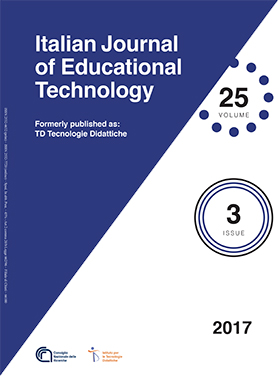Comparing multimodality and traditional writing: an experience in secondary school
Main Article Content
Abstract
Numerous studies focus on how new technologies influence learning to write processes. Nowadays, when considering the writing process, we need to consider changes that have occurred in the concept of textuality: multiple forms can be considered as texts, and texts can be multimodal. Modes such as words, audio, images, hyperlinks and video are all signs that carry meaning. This study analyses the relationship between traditional writing and new ways of expression, analysing the effects of a multimodal approach to the writing of the essay that Italian students are traditionally required to produce at the end of secondary school.
Article Details
Section
Authors who publish with this journal agree to the following terms:
- Authors retain copyright and grant the journal right of first publication with the work simultaneously licensed under a Creative Commons CC BY 4.0 Attribution 4.0 International License.
- Authors are able to enter into separate, additional contractual arrangements for the non-exclusive distribution of the journal's published version of the work (e.g., post it to an institutional repository or publish it in a book), with an acknowledgement of its initial publication in this journal.
- Authors are permitted and encouraged to post their work online (e.g., in institutional repositories or on their website) prior to and during the submission process, as it can lead to productive exchanges, as well as earlier and greater citation of published work (See The Effect of Open Access)
References
Benson, R. (2014). REVIEW: We Have Always Already Been Multimodal: Histories of Engagement with Multimodal and Experimental Composition. College English, 77(2), 165-175.
Bezemer, J., & Kress, G. (2008). Writing in Multimodal Texts: A Social Semiotic Account of Designs for Learning. Written Communication, 25(2), 166-196.
Boscolo, P. (2014). Motivare a scrivere nell’era digitale. Quaderni di didattica della scrittura, 21-22, 97-121.
Cardarello, R., & Contini, A. (a cura di) (2012). Parole immagini metafore. Per una didattica della comprensione. Parma, IT: Edizioni Junior - Spaggiari.
Cohen, L., Manion, L., & Morrison, K. (2011). Research methods in education. London, UK: Routledge.
Cope, B., & Kalantzis, M. (2009). “Multiliteracies”: New Literacies, New Learning. Pedagogies: An International Journal, 4(3), 164-195.
Del Longo, S., & Cisotto, L. (2014). Writing to Argue: Writing as a Tool for Oral and Written Argumentation. (2014). In P. Klein, P. Boscolo, L. Kirkpatrick, & C. Gelati (Eds.), Writing as a Learning Activity (pp. 14-43). Boston, MA: Brill.
Jewitt, C. (Ed.) (2011). The Routledge Handbook of Multimodal Analysis. London, UK: Routledge.
Jonassen, D., Howland, J., & Marra, R. M. (2013). Meaningful Learning with Technology. Boston, MA: Pearson New International Edition.
Karchmer-Klein, R. A. (2013). Best practices in using technology to support writing. In S. Graham, C. A. Macarthur, & J. Fitzgerald (Eds.), Best practices in writing instruction (pp. 309-333). New York, NY: Guilford.
Karchmer-Klein, R., & Shinas, V. H. (2012). 21st Century Literacies in Teacher Education: Investigating Multimodal Texts in the Context of an Online Graduate-Level Literacy and Technology Course. Research in the Schools, 19(1), 60-74.
Kress, G. (2003). Literacy in the new media age. London, UK: Routledge.
Kress, G., & Van Leeuwen, T. (1996). Reading Images. The Grammar of Visual Design. London, UK: Routledge.
Laneve, C. (2014). Le due ali della scrittura. Quaderni di didattica della scrittura, 21-22, 7-17.
Lawless, K. A, & Pellegrino, J. W. (2007). Professional Development in Integrating Technology into Teaching and Learning: Knowns, Unknowns, and Ways to Pursue Better Questions and Answers. Review of Educational Research, 77(4), 575-614.
Magnifico, A. M. (2010). Writing for whom? Cognition, Motivation, and a Writer’s Audience. Educational Psycologist, 45(3),167-184.
Maragliano, R. (2014). Scrittura volatile. Quaderni di didattica della scrittura, 21-22, 38-52.
Martinec, R., & Salway A. (2005). A system for image–text relations in new (and old) media. Visual Communication, 4(3), 337-371.
Mayer, R. E. (2001). Multimedia learning. New York, NY: Cambridge University Press.
Thomas, A. (2011). Children’s writing goes 3D: a case study of one primary school’s journey into multimodal authoring. Learning, Media and Technology, 37(1), 77-93.

